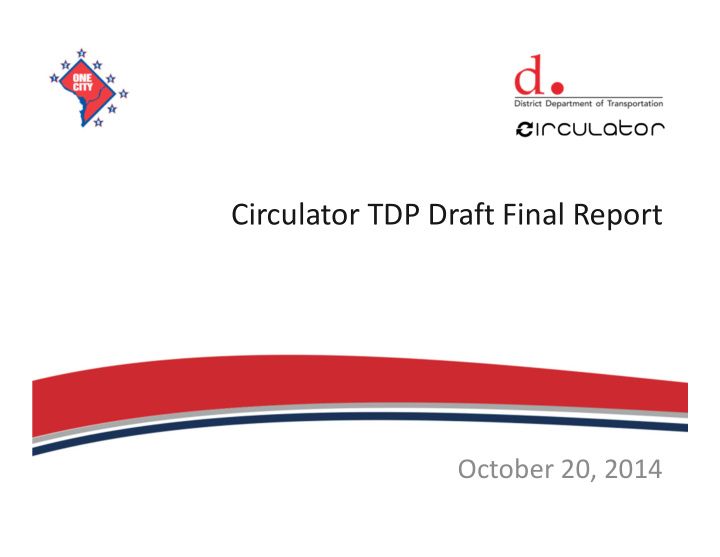



Circulator TDP Draft Final Report October 20, 2014
Planning Process Update Operations Analysis Stakeholder Input Public Outreach Update Activity Center Analysis Prioritize Future Growth 2
Public Outreach • Stakeholder Outreach • Operator Focus Group • Online Survey • Six Pop ‐ Up Events 3
Existing System Analysis • Changes since 2011 TDP • System and Route Performance • Key Findings 4
Existing System Key Recommendations • Deploy additional vehicles to meet service commitment • Bus stop consolidation • Evaluate changes to schedule and span • Consider options to adapt to underutilization • Deploy priority bus treatments 5
Activity Center Analysis • Activity centers are mixed ‐ use centers that include employment, residences, recreational and cultural uses, and retail activities. • Activity centers serve multiple trip purposes and are therefore more likely to generate ridership demand that warrants all ‐ day frequent service. 6
Activity Centers 7
Corridor Planning Process • Identify Activity Centers • Evaluate Activity Centers • Develop Initial set of Corridors • Screen Corridors • Finalize Corridors • Phase Corridors 8
Identify Corridors • Review of the recommended corridors in the 2011 TDP • Gaps identified among the activity center connections • Inputs from existing DDOT and WMATA transit service studies • Planned future premium transit investment, such as the Metro Extra and the DC Streetcar • Suggestions from the DC Council, Circulator riders, and the public 9
Corridor Evaluation • Number of activity centers served • Size of activity centers served • Variety of land uses at activity centers served PLANNING • Timing of development in activity centers served CRITERIA FOR EVALUATING • Link to other non ‐ auto transportation modes GROWTH • Complement existing transit options CORRIDORS • Connections between the National Mall and activity centers • Number of visitor destinations served 10
Recommended Corridors 11
Corridor Phasing Phase New Routes Extensions Georgetown – Union Station Extension to • National Cathedral Union Station – Navy Yard Extension to • Southwest Waterfront Phase I (2014 ‐ 2017) National Mall Dupont Circle – Georgetown – Rosslyn • Extension to U St/Howard University Potomac Ave Metro – Skyland Extension to • Congress Heights 12
Corridor Phasing Phase New Routes Extensions Convention Center – Southwest Waterfront • Phase II (2018 ‐ 2020) None New Service to NoMa • Phase New Routes Extensions Dupont – Southwest Waterfront – Navy Yard • Phase III (2021 ‐ 2024) Columbia Heights – Washington Hospital None • Center – AFRH – Brookland – NoMa 13
Policy Recommendations • Replacement of aging fleet • Coordinated marketing strategy and efforts • Additional buses on routes to increase reliability and meet 10 ‐ minute schedule headways • Evaluate changes to schedule and span • Consider options to adapt to underutilization 14
Recommend
More recommend